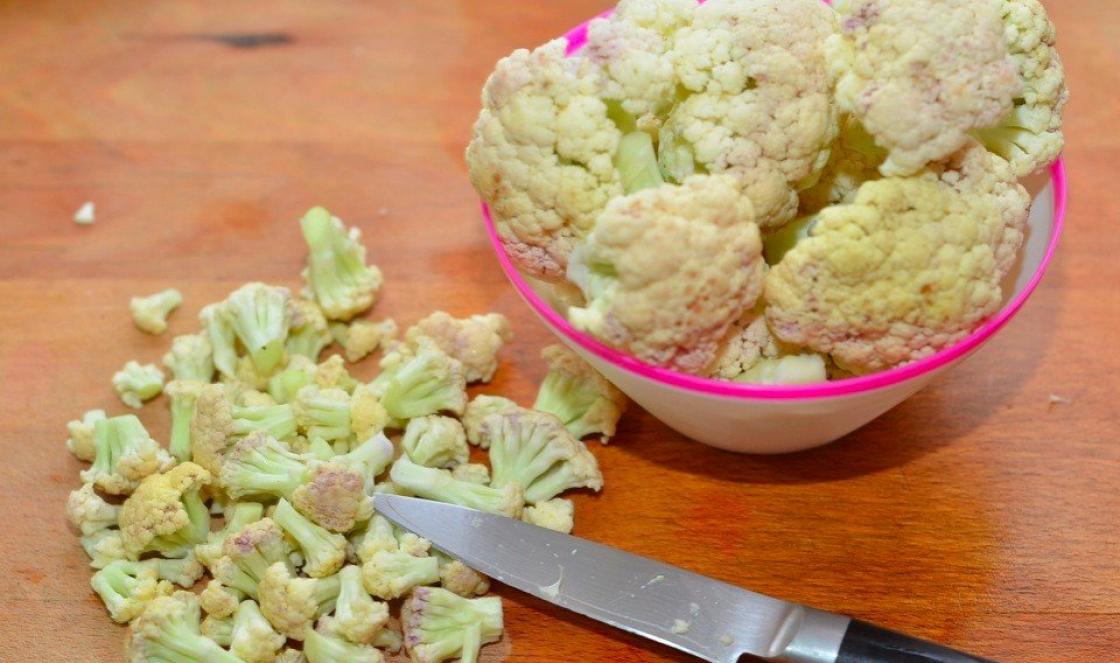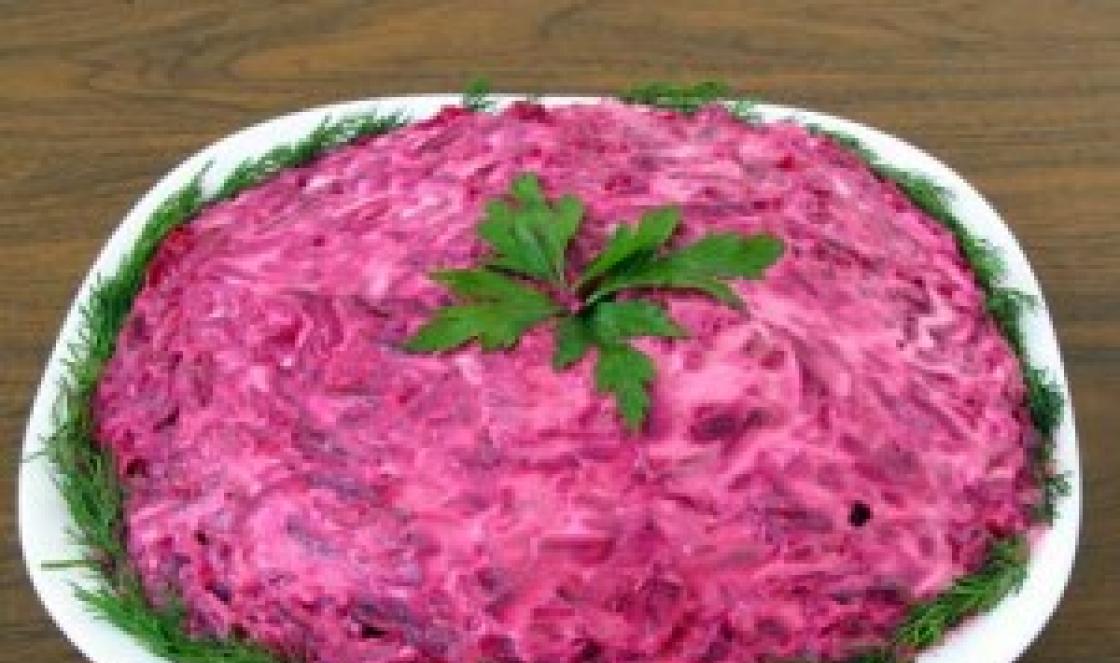This is the national dish of perhaps every country, with a slightly different recipe. Festivals dedicated to this wonderful fermented vegetable are held in Russia and China, Great Britain and Germany. In this recipe I would like to suggest preparing it with dill seeds. It turns out very tasty.
You only need a few ingredients and it's inexpensive. The main thing is seasonality, it is better to do this in the fall, when the vegetable will give enough juice and will be fermented in its own brine.
Cabbage is high in vitamins and ascorbic acid, a dietary and very tasty product that improves stomach functions, and its juice is an ideal remedy for dehydration.
Ingredients:
- White cabbage - 1 fork
- Carrots - 1 pc.
- Dill seeds - 1 tsp.
- Salt - 100 g
Step-by-step preparation photos:
Cut the cabbage into thin strips or grate it on a special grater. When chopped, it should fill a 3.5 liter pan.
Transfer it into a jar (together with the juice you get 3 liters) and put it in the refrigerator for storage so that it does not ferment further and its taste does not deteriorate.
Bon appetit everyone!
Our Slavic people have respected sauerkraut since the times of Ancient Rus'. Tasty, healthy, it was considered an excellent panacea for many diseases. They approached the cooking process creatively, with all their heart! Almost the whole family took part: both old and young. Men prepared the oak barrels (washed, cleaned, processed), children prepared the cabbage itself (peeled the top leaves), and women and girls were engaged in the pickling process itself. Often neighbors (young girls and women) came to visit and, singing, chopped and salted this product. It was believed that this should only be done in a good, cheerful mood, otherwise the sauerkraut will not turn out and will be bitter and tasteless.
Sauerkraut is found in the cuisines of almost all countries of the world: both eastern (Japan, China) and European (Germany, Sweden, Denmark and many others). The recipes and taste are different, of course, but very similar.
This product is especially popular in the autumn-winter season. After all, this is not only a good salad or appetizer, but also the basis for many dishes, such as vinaigrette, cabbage soup, pies, solyanka, dumplings and many others.
The benefits of this dish for the body are enormous. The presence of vitamin C in huge quantities (even more than in lemons) improves immunity and helps prevent colds and viral diseases, and also helps lower blood pressure by thinning the blood. So, this dish will be useful for everyone who is prone to blood clots.
Nutritionists love this product for its so-called negative calorie content (that is, it contains fewer calories than the body needs to process it).
To make cabbage successful, you need to know a few simple rules for pickling it:
- Forks. It is necessary to pay attention to color and density. A good cabbage should be dense and white; only winter varieties of cabbage are used for pickling.
- Tara. The container in which the fermentation process will take place must be made of natural, non-oxidizing materials (glass, clay, enamelware).
- Temperature. The first days the temperature should be room temperature. The foam that forms on the surface must be removed. After it stops foaming and the brine becomes clear, you can clean the cold room (cellar, basement or refrigerator).
In addition to dill seeds, you can add black and allspice and bay leaves (after chopping a little first).
Rate the recipe
|
- cabbage - a dense head of 3-4 kg.,
- carrots - 2-3 pcs.,
- dill seeds - 1-2 tbsp.,
- salt.
How to make homemade sauerkraut in a jar:
For pickling cabbage, it is best to use winter varieties of cabbage, such as “Slava”, “Snow White” or “Sugarloaf”. This recipe uses the Slava variety. I also want to say that from a large head of dense cabbage, weighing 3-4 kg. it turns out a full filled jar with a volume of 3 liters. Therefore, before fermenting cabbage, think about how much you will need.

It is convenient to ferment cabbage over a large area, using either a large table or a long work surface. Wash and dry the cabbage.

Cut the head of cabbage in half.


Then, if required, you can further chop the cabbage.

Mash the cabbage with your hands until the juice comes out.

Separately, grate the cabbage on a coarse grater. Add to cabbage.

Add salt and dry dill seeds to taste.

Mix everything again and knead well.
Be sure to taste the cabbage for salt. And if required, add more to taste.

The cabbage is almost ready, we begin to stuff it into jars, tamping it with our hands or using a mortar.

Fill the jars full, leaving room for the juices to release.

Keep the jar of cabbage for 3-4 days at room temperature, occasionally piercing it to the very bottom with a long knife or wooden stick.

On the second or third day, a sufficient amount of cabbage juice will be released, which may overflow. To do this, place the jar in a deep plate so that the excess brine drains off.
After the cabbage has been salted, send it to a cool place: a cellar or refrigerator, closing it tightly with a lid.

Delicious, crispy sauerkraut with carrots and aromatic dill seeds will not leave anyone indifferent. It is perfect as a snack for both everyday and holiday tables. It’s not for nothing that our grandfathers and great-grandfathers used to eat healthy and wholesome food, such as boiled potatoes and sauerkraut... mmm, what could be tastier? Therefore, be sure to prepare a couple of jars of sauerkraut for future use.
Sauerkraut with dill seeds is the best side dish for meat, as it neutralizes excess fat in meat. This recipe allows you to pickle white cabbage all year round. Dill seeds add a pleasant aroma to this popular winter preparation. It turns out crispy, juicy, tasty and very healthy. Sauerkraut contains much more vitamin C than fresh cabbage.
For pickling, you can use wooden barrels, enamel pots and buckets, or three-liter glass jars. The main thing is that the cabbage variety should be pickled, since cabbage intended for long-term storage, salted in the usual way, will turn out dry and hard, while early cabbage will be very soft. The optimal temperature for fermenting cabbage is 18-20 degrees.
Recipe
Ingredients:
- 5 kg white cabbage
- 500 grams of carrots
- 100 grams of salt
- 2 teaspoons dill seeds
- 8-10 pcs. bay leaf
Cooking method
- Peel white cabbage of pickling varieties from the top leaves, cut into two parts, remove the stalks and finely chop with a knife or a special shredder.
- Peel the carrots and grate on a coarse grater.
- Place clean cabbage leaves, some dill seeds, and a couple of bay leaves on the bottom of an enamel container. You can add a few peas of allspice.
- Mix shredded cabbage with carrots, dill seeds and salt.
- Place the cabbage and carrots in a container, pressing down each new layer and adding a couple of bay leaves.
- Place a wooden circle or an ordinary small plate on top of the cabbage and apply pressure so that the cabbage is always in the brine. The simplest oppression can be a three-liter jar of water, closed with a lid.
- Place the container with cabbage in a warm place for 3 days for fermentation: on the 3rd day, foam usually appears on the brine, and the brine itself becomes sour.
- After 3 days, remove the pressure and pierce the cabbage in several places to remove fermentation gases (it’s even better to stir the cabbage if the container allows). Let it stand open for several hours, occasionally piercing the cabbage in different places.
- The finished cabbage can be transferred from the pickling container into glass jars and placed in a cool place.
- After three to five days, sauerkraut with dill seeds is ready to eat.
To prepare sauerkraut, you will need:
Cabbage - a dense head of 3-4 kg.,
- carrots – 2-3 pcs.,
- dill seeds – 1-2 tbsp.,
- salt.
How to make homemade sauerkraut in a jar:
For pickling cabbage, it is best to use winter varieties of cabbage, such as “Slava”, “Snow White” or “Sugarloaf”. This recipe uses the Slava variety. I also want to say that from a large head of dense cabbage, weighing 3-4 kg. it turns out a full filled jar with a volume of 3 liters. Therefore, before fermenting cabbage, think about how much you will need.
It is convenient to ferment cabbage over a large area, using either a large table or a long work surface. Wash and dry the cabbage. 
Cut the head of cabbage in half. 

Then, if required, you can further chop the cabbage. 
Mash the cabbage with your hands until the juice comes out. 
Separately, grate the cabbage on a coarse grater. Add to cabbage. 
Add salt and dry dill seeds to taste. 
Mix everything again and knead well.
Be sure to taste the cabbage for salt. And if required, add more to taste. 
The cabbage is almost ready, we begin to stuff it into jars, tamping it with our hands or using a mortar. 
Fill the jars full, leaving room for the juices to release. 
Keep the jar of cabbage for 3-4 days at room temperature, occasionally piercing it to the very bottom with a long knife or wooden stick. 
On the second or third day, a sufficient amount of cabbage juice will be released, which may overflow. To do this, place the jar in a deep plate so that the excess brine drains off.
After the cabbage has been salted, send it to a cool place: a cellar or refrigerator, closing it tightly with a lid. 
Delicious, crispy sauerkraut with carrots and aromatic dill seeds will not leave anyone indifferent. It is perfect as a snack for both everyday and holiday tables. It’s not for nothing that our grandfathers and great-grandfathers used to eat healthy and wholesome food, such as boiled potatoes and sauerkraut... mmm, what could be tastier? Therefore, be sure to prepare a couple of jars of sauerkraut for future use. I also advise you to find out how to prepare




